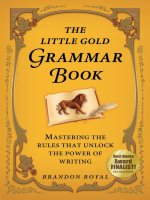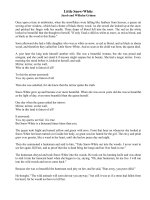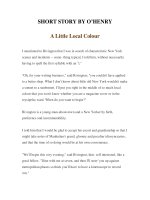nursery rhyme readers little miss muffet
Bạn đang xem bản rút gọn của tài liệu. Xem và tải ngay bản đầy đủ của tài liệu tại đây (5.12 MB, 14 trang )
Little
Miss Muffet
Illustrated by Virginia Allyn
No part of this publication may be reproduced in whole or in part or stored in a retrieval system, or transmitted in any
form or by any means, electronic, mechanical, photocopying, recording, or otherwise, without written permission of the
publisher. For information regarding permission, write to Scholastic Inc., 557 Broadway, New York, NY 10012.
Designed by Jaime Lucero
ISBN: 978-0-545-26773-1
Copyright © 2010 by Scholastic Inc.
All rights reserved. Published by Scholastic Inc.
12 11 10 9 8 7 6 5 4 3 2 1 10 11 12 13 14 15/0
N
u
r
s
e
r
y
R
h
y
m
e
N
u
r
s
e
r
y
R
h
y
m
e
READERSREADERS
Nursery Rhyme Readers: Little Miss Muffet © Scholastic Teaching Resources
2
Little Miss Muffet
Nursery Rhyme Readers: Little Miss Muffet © Scholastic Teaching Resources
3
sat on a tuffet,
Nursery Rhyme Readers: Little Miss Muffet © Scholastic Teaching Resources
4
eating some curds and whey.
Nursery Rhyme Readers: Little Miss Muffet © Scholastic Teaching Resources
5
Along came a spider,
Nursery Rhyme Readers: Little Miss Muffet © Scholastic Teaching Resources
6
who sat down beside her,
Nursery Rhyme Readers: Little Miss Muffet © Scholastic Teaching Resources
7
and frightened
Nursery Rhyme Readers: Little Miss Muffet © Scholastic Teaching Resources
8
Miss Muffet away!
Nursery Rhyme Readers: Little Miss Muffet © Scholastic Teaching Resources
6
Teaching Tips
To enhance children’s reading experiences, use these tips
as you introduce and share the Nursery Rhyme Readers.
Before Reading
Show the cover of the book and read aloud the title.
Have children comment on the cover illustration and
tell what they know about the nursery rhyme. Since
nursery rhymes often contain unfamiliar vocabulary,
skim the book and introduce any vocabulary that will help
children’s understanding of the story. For example, for Little
Miss Muffet, discuss tuffet, curds, and whey.
During Reading
The first time through, read the nursery rhyme aloud from beginning to end to let children hear the
rhyme, enjoy it, and get a feel for the language. On subsequent readings, help engage children in the
reading process by following these suggestions.
L
Model reading for children by tracking a line of print from left to right, turning the pages, and
using picture clues. Invite children to comment on the illustrations on each page.
L
Reread the story, asking children to listen for words that rhyme. Then read aloud again, this time
stopping at words that rhyme and letting children chime in on them. Next, invite children to join
in for a shared reading, pointing to each word as you read it.
L
Model strategies for decoding words, such as finding beginning sounds, using picture clues, and
sounding out words.
L
Point out punctuation and capital letters. Discuss what symbols such as periods,
commas, questions marks, and exclamation marks mean, and how they affect the
reading of the rhyme.
L
Invite children to clap their hands along with you to the rhythm of the rhyme as
you read aloud.
After Reading
Help children respond to the nursery rhyme by following these suggestions.
L
Ask questions to check for understanding. For example, after reading
Humpty Dumpty, ask questions such as: What happened to Humpty when he
fell? Who tried to help Humpty after he fell? Why couldn’t the king’s horses and
men put Humpty back together?
Nursery Rhyme Readers Teaching Guide © Scholastic Teaching Resources
7
L
Ask children if they liked the rhyme, and what they liked most or least.
Have them retell the rhyme in their own words.
Using the Reproducible Nursery Rhyme Pages
After reading a nursery rhyme several times, give children a copy of the nursery
rhyme reproducible to use for independent reading, for reading in pairs or groups,
for classroom activities, and for sharing with
family members. These pages are a great way to
encourage repeated readings, develop fluency, and
to do specific skill work.
Have children make a folder of the nursery
rhyme pages. Provide a blank folder for children to
title “My Nursery Rhymes,” and let them decorate
it. Have them insert the nursery rhymes as they read
them. They can also keep the Nursery Rhyme
Reader Log in the folder, as well as activity
sheets that they complete. Let children take
home the folder to share with family members
from time to time.
Have children follow along as you read
the rhyme, tracking the print as you read. Ask them to underline or circle
the rhyming words on their sheet. Also use the pages to have children
identify specific letters, words with specific consonants, blends, vowel
patterns, phonograms, and sight words. (You might wish to enlarge one copy
of the rhyme and place it on an easel for children to see.)
Some of the lesson pages have specific suggestions for using the reproducible
versions of the nursery rhymes.
Using the Lesson Pages and Reproducible
Activity Pages
For each Nursery Rhyme Reader, use the activities on the lesson page found in
this teaching guide to delve further into the areas of phonemic awareness, phonics,
comprehension, vocabulary, reading, and writing. Each nursery rhyme includes a
reproducible activity page specific to it. Spread the lesson and activities for each
rhyme over several days.
Nursery Rhymes Readers Teaching Guide •
© 2010 Scholastic • 26
Mary Had a
Little Lamb
Mary had a little lamb
with fleece as white as snow.
And everywhere that Mary went,
the lamb was sure to go.
He followed her to school
one day,
which was against the rule.
It made the children laugh and
play to see a lamb at school.
Nursery Rhymes Readers Teaching Guide •
© 2010 Scholastic • 42
Name ___________________________________________________________
Mary Had a Little Lamb
Write Your Own Story!
Mary’s lamb followed her
__________________________________________
_____________________________________________________________________________
.
What happened?
_____________________________________________________
_____________________________________________________________________________
.
to soccer
practice.
It got the ball and
butted it into the goal.
Jack
Nursery Rhyme Readers Teaching Guide © Scholastic Teaching Resources
Nursery Rhyme Readers Teaching Guide •
© 2010 Scholastic • 28
Little
Miss Muffet
Little Miss Muffet
sat on a tuffet,
eating some curds and whey.
Along came a spider,
who sat down beside her,
and frightened
Miss Muffet away!
29
Little Miss Muffet
Learning With the Nursery Rhyme
See pages 6–7 for suggested ways to read and share the book with children. Then focus on the
following activities.
What Is It? Ask children if they can tell what the word tuffet means and how they know.
Point out that they can use picture clues and word clues to figure out the word’s meaning.
The word sat lets them know that Miss Muffet is sitting on something, and the picture
shows them what it is. Explain that a tuffet is an old-fashioned word for a low stool with
a soft cushion on it. Then, ask children to follow the same process for the phrase curds
and whey. Explain that this is a food from long ago that is like cottage cheese. Next, use
nonsense words instead of real words and give children clues to guess the word’s meaning.
For example:
What is a glubok?
It is a sweet, sticky treat.
You hold it in your hand on a stick.
You lick it.
(a lollipop)
Rhyme It! Write uffet on chart paper and have children read the pattern aloud with you. Then
write M on a sticky note and add it to uffet and have children blend the word: “/m/. . . uffet.” Now
write t on a sticky note and have children blend the word: “/t/. . . uffet.” Continue changing the
beginning letter to make nonsense words, inviting children to suggest consonants or consonant
clusters to add. Next, ask children to complete new rhymes such as the ones below, and also
encourage them to dictate their own new rhymes.
Little Miss Bear sat on a _________.
Little Miss Ked sat on a _________.
Little Mr. Mike sat on a _________.
Little Mr. Slouch sat on a _________.
Oh, My! Invite children to share their feelings about spiders. Do they like them?
Are they scared of them? What would they do if a spider came near them? Extend
the discussion to talk about other things children are afraid of and how they handle
their fears. Then, copy and distribute the story prompt sheet on page 43. Have
children write or dictate to complete the sentences and then draw a picture to
illustrate it. Invite children to share their pages with the class.
Double Letters Distribute the reproducible version of the nursery rhyme. Have
children circle the double letters in the words Little, Miss, Muffet, and tuffet. Invite
them to look around the classroom and in books to search for words with double
letters. Have them write (or dictate) the words on index cards. Post them on a
bulletin board and have children circle the double letters. Here are some words to
get started: letter, hiccups, running, silly, mitten, kitten, wiggle, buzz, hiss, penny, eggs.
Nursery Rhymes Readers Teaching Guide •
© 2010 Scholastic • 43
Name ___________________________________________________________
Little Miss Muffet
Oh, My!
I am frightened when
________________________________________________
_____________________________________________________________________________
.
I feel better when
______________________________________________________
______________________________________________________________________________
_____________________________________________________________________________
.
I have a bad
dream
my mom comes
in and tells me everything
is ok.
Lily
chair
bed
bike
couch
Nursery Rhyme Readers Teaching Guide © Scholastic Teaching Resources
Nursery Rhymes Readers Teaching Guide •
© 2010 Scholastic • 43
name ___________________________________________________________
Little Miss Muffet
Oh, My!
I am frightened when ________________________________________________
_____________________________________________________________________________.
I feel better when
______________________________________________________
______________________________________________________________________________
_____________________________________________________________________________.









